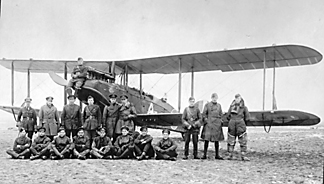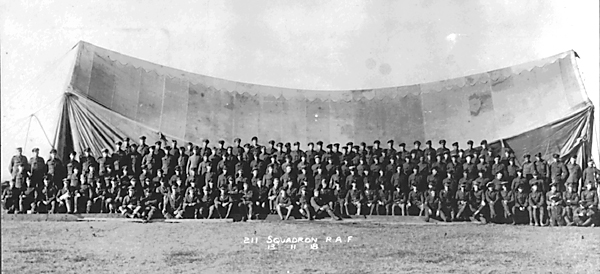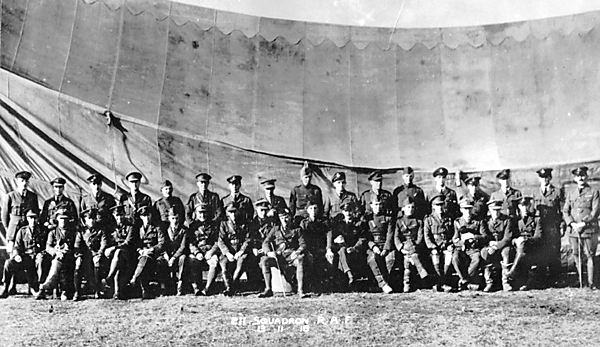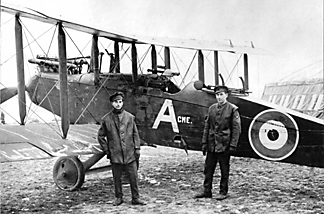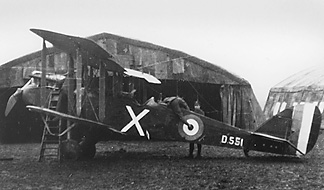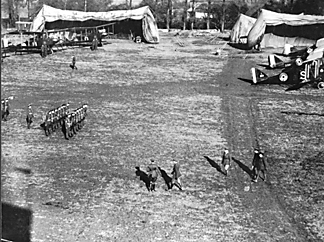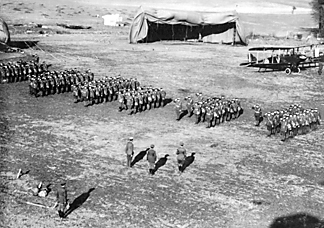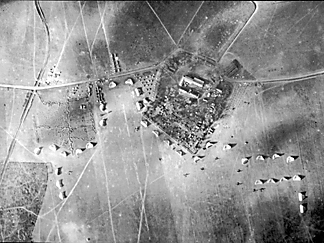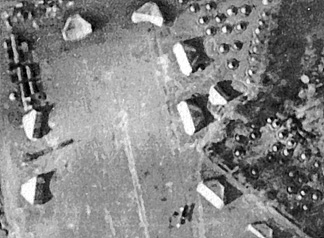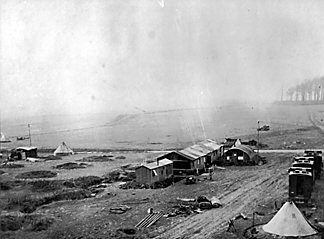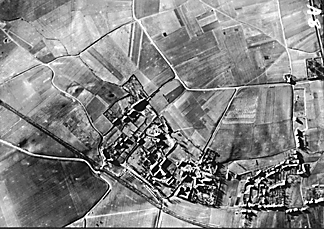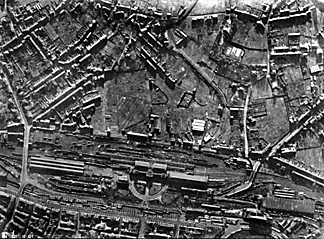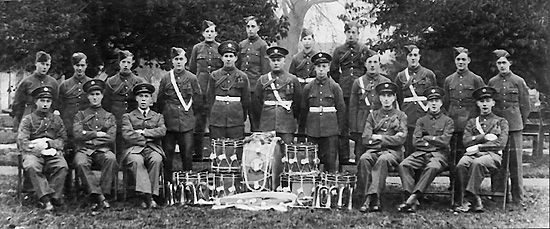|
211 Squadron in World War I
No 211 Squadron RAF formed on 1 April 1918 out of No 11 Squadron RNAS, which itself had re-formed as a bomber squadron at Petite Synthe on 10 March 1918 after a brief existence as a RNAS fighter unit from March to August 1917.
211 Squadron RAF ‘A’ Flight Officers and mechanics with DH9 A-Acme 1918
(Norrie Collection, 211 Newbury Squadron ATC)
Album title: ‘A’ Flight Officers and mechanics
Most things in Service life have a reason and that includes the apparently simple Squadron numbers, where the old RNAS Squadrons that reappeared in the RAF gained their new numbers by the simple expedient of adding 200 to their original identity.
Movements and equipment
|
Date
|
Remarks
|
|
|
10 March 1918
|
Re-formed as No 11 (Naval) Squadron RNAS
Petite Synthe, Dunkirk
|
|
|
March 1918
|
DH4 (April 1918)
|
|
|
April 1918
|
DH9 (March 1919)
|
|
|
1 April 1918
|
Redesignated as no 211 Squadron RAF
|
|
|
24 October 1918
|
Iris Farm, near Clary
|
|
|
3 December 1918
|
Thuillies, near Charleroi
|
|
|
15 March 1919
|
Wyton
|
|
|
24 June 1919
|
Disbanded
|
|
Operations, Flanders 1918
Summary of operations
|
Item
|
Remarks
|
No
|
|
|
Aircraft: DH9, BHP engine (200hp and 230hp)
|
Number of replacements
|
64
|
|
|
Enemy aircraft
|
Destroyed
|
19
|
|
|
|
Completely out of control
|
16
|
|
|
Weight of bombs dropped
|
Tons
|
150
|
|
|
Reconnaissance
|
Sorties
|
100
|
|
|
Reconnaissance (photographic)
|
Sorties
|
105
|
|
From March to the end of August 1918, the Squadron attacked over 30 objectives in Flanders with its Airco DH9 aircraft, many repeatedly. The bombing raids were directed, for the most part, against the German submarine campaign through repeated attacks on Bruges Docks, on Zeebrugge Mole and Harbour, and on Ostende Docks. While post-war analysis eventually showed that the anti-submarine campaign was nowhere near as successful as first thought in terms of U-boats destroyed, the Germans were put to a great deal of trouble by the incessant attacks upon their port facilities.
9 May 1918
“The weather was fine with considerable haze. 27 tons of bombs were dropped. Enemy aircraft were fairly active in the whole front [...]
Lt W Gillman and 2nd Lt R Lardner, 211 Sqn, whilst returning from a bomb raid encountered an EA [Enemy Aircraft] Triplane. A few rounds were fired into the EA and it went down in flames over Zeebrugge mole.”
RAF Communique
19 May 1918
“The weather was fine. 32 tons of bombs were dropped. Enemy aircraft activity was slight on the front[...]
Lt JS Forgie and 2nd Lt JS Muir, 211 Sqn, were attacked by several EA while on a bombing raid over Blanckenburghe. The Observer fire 30 rounds into one EA, which nosed-dived and caught fire on hitting the ground.”
RAF Communique
13 August 1918
“Weather fine. 21½ tons of bombs were dropped by night and 20½ tons by day. Enemy aircraft active.[...]
A raid was carried out [...] on Varssenaere Aerodrome [...]. 211 Sqn bombed the aerodrome after the low flying attack was over, and demolished the chateau.”
RAF Communique
These operations were carried out while the Squadron was co-operating with the Royal Navy, and their success drew messages of congratulation from the Vice-Admiral, Dover Patrol and later from GOC 5th Group RAF, Brig Gen GL Lambe.
Bombing operations from late August were also made in support of the Belgian Army. During this time there was “nearly always a scout Squadron told off for escort” (211 Squadron History TNA AIR 1/696/21/20/211). The Squadron’s objectives at that time included aerodromes and ammunition and supply dumps.
Of the final month of their bombing offensive, conducted in support of the 2nd Army from 28 September 1918, the Squadron History remarked:
“From 28/9/18 until it departed to another Brigade, 211 Squadron worked without escort. This was during the Ypres offensive when all scout Squadrons were employed on low bombing and machine-gunning. Many large formations of EA [enemy aircraft] were met during this period but the close formation kept by 211 Squadron kept its casualties at the very minimum.”
TNA AIR 1/696/21/20/211
From late October 1918, the Squadron operated purely as a reconnaissance and photographic unit, continuing to give a good account of itself against enemy aircraft in carrying out its duties. During a photographic reconnaissance sortie in the final week of the Great War, a formation of 211 Squadron DH9s shot down 3 Fokker biplanes and drove another down out of control.
4 November 1918
“Weather: mist in early morning, fine afterwards. 6½ tons of bombs dropped by night and 29½ tons dropped by day. Considerable enemy aircraft activity.[...]
A formation of 211 Sqn, while on a photographic reconnaissance, was attacked by a formation of EA whose leader was fired on by the pilots and Observers of two machines—2nd Lts CH Dickins (C) and WJ Large; 2nd Lts WG Watson (C) and Sgt C Lamont. This EA went on fire and broke up, the pilot leaving the machine in a parachute which did not open. 2nd Lt Adam, Observer, fired at another of the EA which passed close above him. This machine fell in a spin and was seen by other officers to burst into flames on hitting the ground. 2nd Lt GE Moore, Observer, also destroyed an EA which was seen to crash by two other Observers.”
RAF Communique
(C) Canadian officer
Note: The matching of personnel as aircraft crews is at odds here with the published account of individual aircraft, below, nor does the Combat in the Air form of the day assist in resolving the conflict.
Squadron losses 1918
In the course of its work over Flanders from March to November 1918, the Squadron suffered the loss of 45 aircrew. Of these, 22 were killed and 23 taken prisoner or interned (Holland had remained neutral, interning aircraft and men who landed on Dutch territory). A further 18 men were wounded, while two died of illness post-war.
|
Aircrew
|
Killed in action,
missing in action,
died of wounds,
killed on air operations
|
Died of illness
|
Wounded
|
Prisoner,
Germany
|
Interned,
Holland
|
|
|
Pilots
|
8
|
|
8
|
5
|
7
|
|
|
Observers
|
14
|
|
10
|
5
|
6
|
|
|
Other
|
|
2
|
|
|
|
|
|
Total
|
22
|
2
|
18
|
10
|
13
|
|
Source: History of 211 Squadron RAF TNA AIR 1/696 21/20/211, amended from known aircraft and other CWGC records.
Honour Roll
As 211 Squadron RAF, their first casualty of the war was 2nd Lt HM Moodie: seconded from the Seaforth Highlanders and flying as an Observer, he died of wounds on 6 April 1918.
With the casual brutality of war, their last loss in action came on the day before the Armistice: 2nd Lt JHR Smith, Observer, died after his aircraft D7362 was hit by enemy fire during a reconnaissance sortie on 10 November 1918.
The Great War had come to an end but that Winter, the first and most terrible influenza epidemic was already spreading. So in the first Spring of peace came the Squadron’s final losses: driver AC2 Charles Forehead 239101 aged 19, and photographer LAC Karl Krall 52276. Forehead’s original grave registration papers record him in error as a member of 111 Squadron but his admission to hospital was noted in the last of 211 Squadron’s Return of Casualties to All Ranks for February 1919.
Compiled from material kindly supplied by the Commonwealth War Graves Commission, from Sturtivant and Page’s DH4/DH9 File, from unpublished research kindly shared by John Grech and from the 211 Squadron Returns of Casualties to All Ranks (TNA AIR 1/930/204/242/13) and Casualty Reports to Personnel and Machines (AIR 1/1930/204/242/12), and RAF Museum Story Vault records, this roll now records the death of 24 men of 211 Squadron RAF in the course of World War I.
Eight of the 211 Squadron dead of the Great War lie in Dunkirk Town Cemetery, where 460 Commonwealth men of the First World War rest. Five others are commemorated on the Arras Flying Services Memorial for the nearly 1,000 Commonwealth airmen lost over the Western Front with no known grave. Wherever they lie, all are commemorated by the Commonwealth War Graves Commission.
|
Name
|
Rank
|
Duty
|
Age
|
Date
|
Remarks & DH9 serial
|
Cemetery or memorial
|
|
WJ Atkinson
|
AC1
|
Observer
|
|
13 Jul 1918
|
Force-landed at sea near Nieuport —drowned. B9346
|
Flushing (Vlissingen) Northern
|
|
SJ Bence
|
Cpl
|
Observer
|
20
|
13 Aug 1918
|
KIA, B7614
|
Hoogstade War
|
|
JB Blundell
|
2nd Lt
|
Observer
|
|
29 Sep 1918
|
KIA, D3093
|
Arras Flying Services Memorial
|
|
CL Bray
|
Lt
|
Observer
|
18
|
19 May 1918
|
KIA, D2784
|
Zeebrugge
|
|
CC Brouncker
|
2nd Lt
|
Pilot
|
20
|
4 Nov 1918
|
MIA, F1157
|
Arras Flying Services Memorial
|
|
VA Fair MC
|
2nd Lt
|
Observer
|
|
29 Sep 1918
|
KIA D565
|
Harlebeke
|
|
CK Flower *
|
2nd Lt
|
Pilot
|
|
15 May 1918
|
KAO, B7600.
CWGC records 218 Squadron
|
Dunkirk Town
|
|
CR Forehead
|
AC 2
|
Driver, petrol
|
19
|
15 Mar 1919
|
Admitted to Hospital 21 Feb 1919. Influenza
|
Marcinelle New
|
|
W Gilman
|
2nd Lt
|
Pilot
|
19
|
13 Jul 1918
|
Force-landed at sea near Nieuport —drowned, missing. B9346
|
Arras Flying Services Memorial
|
|
WJ Johnson
|
2nd Lt
|
Pilot
|
27
|
13 Oct 1918
|
PoW, DoW. E8936
|
Niederzwehren
|
|
K Krall
|
LAC
|
Photographer
|
30
|
28 Feb 1919
|
Pneumonia
|
Charleroi
|
|
TW Kelly
|
2nd Lt
|
Observer
|
19
|
29 Sep 1918
|
KIA, D482
|
Dunkirk Town
|
|
R Lardner
|
2nd Lt
|
Observer
|
|
26 May 1918
|
KIA, D1693
|
Dunkirk Town
|
|
TF Le Mesurier
DSC & 2 bars MID
|
Capt
|
Pilot
|
21
|
26 May 1918
|
KIA, D1693
|
Dunkirk Town
|
|
CD Macdonald
|
2nd Lt
|
Observer
|
18
|
4 Nov 1918
|
MIA, F1157
|
Arras Flying Services Memorial
|
|
IAB McTavish*
|
2nd Lt
|
Observer
|
22
|
15 May 1918
|
KAO, B7600.
CWGC records 218 Squadron
|
Dunkirk Town
|
|
HM Moodie
|
2nd Lt
|
Observer
|
|
6 Apr 1918
|
Died of wounds, B7603
|
Dunkirk Town
|
|
ES Morgan
|
2nd Lt
|
Pilot
|
|
7 Sep 1918
|
KIA, crashed in sea D2918
|
Dunkirk Town
|
|
HM Partridge 317264
|
Sgt
|
Observer
|
18
|
25 Jul 1918
|
Interned but died of wounds, D2781 ‘M’
|
Flushing (Vlissingen) Northern
|
|
R Shephard*
|
Private First class
|
Observer
|
|
25 Jun 1918
|
KIA. CWGC records 211 Squadron but C2176 recorded as a 206 Squadron a/c
|
Arras Flying Services Memorial
|
|
R Simpson
|
2nd Lt
|
Observer
|
19
|
7 Sep 1918
|
KIA, crashed in sea D2918
|
Dunkirk Town
|
|
JHR Smith
|
2nd Lt
|
Observer
|
19
|
10 Nov 1918
|
KIA, D7362
|
Gougnies
|
|
NA Taylerson
|
Lt
|
Pilot
|
|
19 May 1918
|
KIA, D2784
|
Zeebrugge
|
|
AG White
|
Lt
|
Pilot
|
23
|
29 Sep 1918
|
KIA, D3093
|
Dadizeele
New British
|
* Discrepancies between the principal sources are as noted, however, each of these three men appear in the relevant 211 Squadron Return of Casualties on the correct dates (TNA AIR 1/1930 204/242/13 and they may be confidently recorded as Squadron losses.
Prisoners of War and Internees
A roll extracted from Sturtivant and Page’s DH4/DH9 File and reconciled with the Squadron Return of Casualties.
|
Name
|
Rank
|
Duty
|
Age
|
Date
|
Remarks & DH9 serial
|
|
WL Bing
|
2nd Lt
|
Observer
|
|
8 Aug 1918
|
Interned. B7624
|
|
JJ Comerford
|
2nd Lt
|
Observer
|
|
27 Jun 1918
|
Interned. B7620 ‘A’
|
|
F Daltrey
|
2nd Lt
|
Pilot
|
|
25 Jun 1918
|
PoW. C2176 - 206 Sqdn?
|
|
LK Davidson
|
2nd Lt
|
Pilot
|
|
8 Aug 1918
|
Interned. B7624
|
|
JA Dear
|
Lt
|
Pilot
|
|
24 Aug 1918
|
Interned. D7204 ‘J’
|
|
TB Dodwell
|
2nd Lt
|
Observer
|
|
16 Aug 1918
|
Interned. C6348
|
|
WG Gadd
|
2nd Lt
|
Observer
|
|
1 Nov 1918
|
PoW. D3241
|
|
JA Gray
|
Capt
|
Pilot
|
|
27 Jun 1918
|
Interned. B7620 ‘A’
|
|
RS Gude
|
Sgt
|
Pilot
|
|
25 Jul 1918
|
Interned. D2781 'M'
|
|
DR Harris USAS
|
1 Lt
|
Pilot
|
|
16 Aug 1918
|
Interned. B7623 ‘L’
|
|
NB Harris
|
2nd Lt
|
Observer
|
|
21 May 1918
|
PoW. B7661 'E'
|
|
W Henley-Mooney USAS
|
1 Lt
|
Pilot
|
|
29 Sep 1918
|
Wounded, interned. D565
|
|
WJ Johnson
|
2nd Lt
|
Pilot
|
27
|
13 Oct 1918
|
PoW, DoW. E8936 28 Sep 1918
|
|
WE Jones
|
Sgt
|
Observer
|
|
28 Sep 1918
|
PoW. E8936
|
|
RL Kingham
|
2nd Lt
|
Observer
|
|
24 Sep 1918
|
Interned. D3251
|
|
J Munro
|
2nd Lt
|
Observer
|
|
16 Aug 1918
|
Interned. B7623 ‘L’
|
|
J Olorenshaw
|
2nd Lt
|
Pilot
|
|
24 Sep 1918
|
Interned. D3251
|
|
HM Partridge 317264
|
Sgt
|
Observer
|
18
|
25 Jul 1918
|
Interned but died of wounds
D2781 'M'
|
|
JM Payne
|
2nd Lt
|
Pilot
|
|
1 Nov 1918
|
PoW. D3241
|
|
JFJ Peters
|
2nd Lt
|
Observer
|
|
24 Aug 1918
|
Interned. D7204 ‘J’
|
|
HE Tansley
|
2nd Lt
|
Pilot
|
|
21 May 1918
|
PoW. B7661 'E'
|
|
CH Thomas
|
2nd Lt
|
Pilot
|
|
10 Nov 1918
|
PoW. D7362
|
|
RM Wynne-Eaton
|
Capt
|
Pilot
|
|
16 Aug 1918
|
Interned. C6348
|
Wounded in action
A partial roll, extracted from Sturtivant and Page’s DH4/DH9 File.
|
Name
|
Rank
|
Duty
|
Age
|
Date
|
Remarks & DH9 serial
|
|
DJ Avery
|
2nd Lt
|
Observer
|
|
3 Oct 1918
|
B7626 ‘O’
|
|
GH Baker
|
Lt
|
Pilot
|
|
16 Aug 1918
|
B7679
|
|
NG Breeze
|
2nd Lt
|
Observer
|
|
17 Jul 1918
|
B7581
|
|
CWT Colman
|
2nd Lt
|
Observer
|
|
13 Jul 1918
|
B7624 ‘P’
|
|
E Cooke
|
2nd Lt
|
Observer
|
|
9 May 1918
|
B7637 ‘I’
|
|
W Henley-Mooney USAS
|
1 Lt
|
Pilot
|
|
29 Sep 1918
|
Wounded & interned D565
|
|
H Lindsay
|
Sgt Mech
|
Observer
|
|
7 Oct 1918
|
C1168
|
|
CT Linford
|
Lt
|
Observer
|
|
15 Sep 1918
|
D3210
|
|
R Loraine
|
Major
|
Observer
|
|
20 Jul 1918
|
Squadron CO. B7624 ‘P’.
|
|
JL McAdam
|
2nd Lt
|
Pilot
|
|
7 Oct 1918
|
C1168
|
|
CH Miller
|
Lt
|
Pilot
|
|
13 Aug 1918
|
B7614
|
|
J Steel Muir
|
2nd Lt
|
Pilot?
|
|
17 Jun 1918
|
C1168
|
|
HH Palmer
|
2nd Lt
|
Pilot
|
|
14 Jul 1918
|
D2782
|
|
VGH Phillips
|
2nd Lt
|
Pilot
|
|
5 Oct 1918
|
E8872
|
|
AK Robinson
|
2nd Lt
|
Observer
|
|
1 Nov 1918
|
D517
|
|
HB Shaw
|
2nd Lt
|
|
|
7 Oct 1918
|
?
|
|
AF Taylor
|
2nd Lt
|
Observer
|
|
5 Oct 1918
|
E8872
|
Gallantry Awards
The entries which follow arose from the Honours section of the 211 Squadron narrative, prepared in January 1919 under the signature of the CO, Major GRM Reid DSO MC (AIR 696/21/20/211). Citations are shown where possible. More may be added in time.
Distinguished Service Order
1st Lt AF Bonnalie (United States) AIR 696/21/20/211
2nd Lt TB Dodwell
London Gazette 2 November 1918
“On a recent occasion this officer, when acting as Observer, performed a very gallant and meritorious action. In diving to the assistance of another machine, his own machine commenced to fall out of control. Despite this, he continued to engage three enemy machines that were attacking him, and eventually drove them off, an operation that called for great coolness and skill as the shooting platform was most unsteady. Realising that the machine was out of control owing to the loss of lift in the tail plane, half of this being shot away, he left his cockpit, and, climbing along the wing, lay down along the cowling in front of the pilot, enabling the latter to obtain partial control of the machine and head for home. When nearing the ground he climbed back into his cockpit to allow the nose to rise, and the pilot succeeded in safely landing. The presence of mind and cool courage of this officer undoubtedly saved the machine, and deserves the highest praise.”
Supplement to the London Gazette 2 November 1918 Issue No 30989 p12959.
Bonnalie and Dodwell were both subsequently awarded the United States of America Distinguished Service Cross.
Bonnalie’s long flying career is recorded in his biography, with W Lundberg, A Lifetime in Aviation.
Major GRM Reid MC AIR 696/21/20/211, Flight 9 January 1919, Air Ministry 1 January,
London Gazette1 January 1919
No citation, under the general rubric “in recognition of distinguished service”.
2nd Bar to Distinguished Service Cross
Capt TF Le Mesurier DSC & Bar
London Gazette 18 June 1918
“For gallantry and consistent good work. He has at all times displayed the utmost gallantry in action and by his determination and skill has set a very fine example to the pilots of his squadron. On the 23rd April 1918, in spite of bad weather conditions, he successfully dropped bombs on the Ostend Docks from a height of 800 feet amidst very intense anti-aircraft and machine-gun fire. He also made valuable observations. He has taken part in many bomb raids and has destroyed or driven down out of control several enemy machines.”
As F/Lt RNAS, Le Mesurier had been awarded the DSC (London Gazette 12 May 1917) and as Flt Commander RNAS, a first Bar to the DSC (London Gazette 29 August 1917) and a Mention in Despatches (London Gazette 14 September 1917).
Distinguished Flying Cross
Capt H Axford DFC
London Gazette Supplement, 2 November 1918
Lieut. Herbert Axford (Can. Inf.).
“On the 16th August this officer led his formation to bomb certain docks; these docks were exceptionally well guarded, and our planes were heavily handicapped by adverse weather conditions; moreover, the formation had suffered casualties, and his own machine was badly damaged; he nevertheless succeeded in reaching and bombing his objective in the face of an intense barrage. On the following day he again successfully bombed the same objective. Lieut. Axford has taken part in thirty-four successful bomb raids, inspiring all who serve with him by his personal courage and intense devotion to duty.”
[Lt Axford’s gazettal as Acting Captain in the Flying Branch had just appeared in the Gazette of 1 November, with effect from 7 October]
Lieut CH (Punch) Dickins (Canada) London Gazette 3 June 1919: no citation
Lieut JF Drake
London Gazette Supplement, 8 February 1919
Lieut. John Foster Drake. (FRANCE)
“This officer has taken part in seventy successful raids and reconnaissances, and has been conspicuous for his tenacity and devotion to duty. On 1st November he was one of a formation of six that was attacked by twenty-five enemy aeroplanes, and a running fight of eighteen miles ensued. Being the rear unit of the formation, and maintaining that position throughout, the brunt of this severe attack was borne by this officer, and his endurance and skill against overwhelming odds undoubtedly saved the formation.”
Capt WD Gairdner
London Gazette 8 February 1919, Flight 13 February 1919
Lt (A.Capt) William Dalrymple Gairdner
“This officer has carried out 71 successful bombing raids and 11 photographic reconnaissances, displaying brilliant and courageous leadership on all occasions. On November 4, while leading a photographic reconnaissance, he was continuously harassed by enemy scouts. In the engagement four out of the 14 enemy machines were accounted for, Capt Gairdner driving down one out of control. This fine achievement was mainly due to his brilliant leadership.”
Capt HM Ireland
London Gazette 2 November 1918
“On the 29th August this officer was leader of a large formation detailed for a long distance bombing raid on certain enemy docks. A strong and adverse wind was blowing and thick clouds almost obscured the ground, rendering the task of reaching such a distant object one of great difficulty. Carefully studying the compass and making what he considered due allowance for the wind he led his formation to a point which he judged would be in the vicinity of the objective. A break in the clouds showed that he was correct, and the docks were effectually bombed. During the five months Captain Ireland has been with his present squadron he has led forty-three long distance raids, and the foregoing is only one instance of many in which he has shown judgement, skill and determination of a very exceptional nature.”
Capt HN Lett
London Gazette 7 February 1919
Lieut. (A Capt) Harry Nelson Lett
“This officer has carried out 80 successful bombing raids and nine photographic reconnaissances, displaying at all times high personal courage and initiative. On November 1 his formation was attacked by about 25 enemy machines. Although outnumbered by nearly four to one, the formation destroyed one scout and drove down two others out of control. This fine achievement was largely due to Capt. Lett's most able leadership.”
Lieut ES Morgan
London Gazette Supplement, 2 November 1918; Flight 7 November 1918
Lieut. Edward Stanley Morgan
“On August 16th this officer took part in a bomb raid on enemy docks—a well-guarded objective. The weather conditions were most unfavourable. A strong wind compelled the machines to move slowly, and high white clouds made them an easy target for anti-aircraft fire. On nearing the objective the flight leader was shot down and Lieut,
Morgan assumed command. He was met by an intense barrage. A second machine was seen to fall, and the pilot of a third was severely wounded, but Lieut. Morgan, persisting in his attack, reached and successfully bombed the objective. The cool determination and gallantry displayed by this officer deserves high praise.”
Distinguished Flying Medal
222589 Sergeant F Wilkinson
London Gazette Supplement 2 November 1918
No. 222589 Cpl. Fred Wilkinson (Chorley).
“On the 23rd of August, when returning from a bomb raid, this non-commissioned officer's machine was attacked by three enemy aircraft, and, these having been driven off, two others made a second attack. In the engagement Corporal Wilkinson displayed great coolness and judgment in warding off these attacks, driving down one of the machines out of control. He has taken part in forty-two bomb raids, and his experience and example has been of the greatest value to other observers in the squadron.”
Silver Medal for Gallantry in Saving Life at Sea
Wynne-Eaton London Gazette 7 January 1919
Dodwell London Gazette 7 January 1919
Mentioned in despatches
Major GRM Reid DSO MC AIR 696/21/20/211, Flight 20 Jun 1918, Air Ministry 14 June 1918
2nd Lt AM Adam London Gazette 11 July 1919.
2nd Lt (Observer) WC Snowdon (Haig 16 Mar 1919 per War Office certificate 1 Jul 1919 as Snowden)
Commanding Officers
|
Name
|
Rank
|
Dates od command
|
Remarks
|
|
HG Travers DSC
|
Major
|
6 March 1918 to
28 May 1918
|
S/Ldr Herbert Gardner Travers DSC 1891—1958.
RAF Unemployed list as Capt Aug 1919
Later RAFVR Admin & Special Duties Branch, F/Lt Jan 1939, S/Ldr Dec 1941
S/Ldr PFF Air Staff Sep 1943
Deceased 1958.
Brief biography
|
|
R Loraine DSO MC
|
Major
|
29 May 1918 to
20 July 1918
|
Lt Col Robert Loraine DSO MC 1876—1935.
Prominent in British theatre and one of the first 100 British men to become certificated pilots, with a string of aviation firsts in his Log.
Pilot 1910.
RFC 1914,
3 Sqn RFC wounded 22 Nov 1914
5 Sqn RFC 1915
40 Sqn RFC
211 Sqn RAF 1918.
MC 1915, MiD 1915, 1916, 1917, DSO 1917
Wounded 20 Jul 1918 B7624 ‘P’
Biography
|
|
GRM Reid DSO MC & Bar
|
Major
|
25 July 1918 to
9 March 1919
|
Air Commodore Sir George Ranald Macfarlane Reid KCB DSO MC & Bar 1893—1991
Ex Argyll & Sutherland Highlanders. Flying Officer RFC 1915. To 25 Squadron RFC by May 1916, 20 Squadron RFC by July 1916.
MC London Gazette 24 June 1916
MC Bar London Gazette 25 November 1916. CO 18 Squadron RFC March 1917. Victories: 9.
DSO London Gazette 1 January 1919 Permanent RAF commission as S/Ldr 1919.
S/Ldr No 1 School Technical Training Halton c1920, S/Ldr School of Military Administration 23 September 1921, 99 Squadron 1924, later of 206 and 45 Squadrons, Egypt.
W/Cdr 1925, HQ ME 1927. Air Staff, Air Ministry 1932. Grp Cpt July 1932. A/Cdr July 1936, AVM April 1939. AOC Aden 1938 to 1941, AOC West Africa 1944. Retired, Air Vice-Marshal January 1946. Gentleman Usher to HM George VI 1952, to HM Elizabeth II 1952-1959. Service biography..
|
|
HN Lett DFC
|
Capt
|
10 March 1919 to
24 June 1919
|
Later of the Indian Civil Service (Jul 1920)
|
Flight Commanders
|
Name
|
Rank
|
Service
|
Dates
|
Remarks
|
|
TF Le Mesurier DSC & 2 Bars MID
|
Capt
|
RNAS
|
10 March 1918 to
26 May 1918
|
Killed in action 26 May 1918. D1693
|
|
PE Beasley
|
Capt
|
RNAS
|
9 March 1918 to
2 July 1918
|
|
|
HM Ireland DFC
|
Capt
|
RNAS
|
7 March 1918
to 6 October 1918
|
Canada
|
|
JA Gray
|
Capt
|
RNAS
|
27 May 1918 to
27 June 1918
|
Interned, Holland 27 June 1918.
B7620 ‘A’
Air of Authority biography
|
|
HN Lett DFC RFC
|
Capt
|
RFC
|
2 July 1918 to
(11 January 1919)
|
|
|
RM Wynne-Eyton MC
|
Capt
|
RFC
|
5 July 1918 to
16 August 1918
|
Interned, Holland 16 August 1918. C6348
|
|
WD Gairdner DFC
|
Capt
|
RNAS
|
17 August 1918 to
(11 January 1919)
|
F/Lt RAF London Gazette 1 July 1926
To No 100 (B) Squadron RAF, Singapore 16 October 1934 (Flight 8 Nov 1934).
Killed in flying accident, Singapore 1936.
Vickers Vildebeest II K2927 of 100 Squadron hit the sea during a night torpedo drop exercise against HMS Kent in Johore Straits 19 March 1936 (Flight), with the loss of Gairdner as pilot and his crew, LAC TW Watson and AC SP Jenner.
|
|
H Axford DFC
|
Capt
|
RFC
|
7 October 1918 to
(11 January 1919)
|
Canada
|
Other aircrew
A partial roll, compiled from records immediately to hand.
|
Name
|
|
Duty
|
Known service
|
Remarks, including DH9 serial
|
|
AM Adam RAF
|
2nd Lt
|
Observer
|
August to November 1918
|
B7626. 1/3rd share Fokker destroyed 4 November 1918
Mentioned in despatches July 1919
|
|
DA Alexander
|
2nd Lt
|
Observer
|
August 1918
|
|
|
RM Alston
|
2nd Lt
|
Observer
|
October 1918
|
|
|
H Axford
|
Lt
|
Pilot
|
July 1918 to April 1919
|
Canada.
B7598 damaged 9 July 1918, no injury.
DFC for action while leading formation 16 August 1918 (November 1918).
Acting Captain November 1918, wef 7 October 1918
|
|
AB Bedford
|
2nd Lt
|
Observer
|
August 1918
|
|
|
WF Blanchfield
|
Lt
|
Pilot
|
November 1918
|
E8880. Fokker DVII 9 November 1918
|
|
AF Bonnalie
|
1st Lt
|
Pilot
|
August 1918
|
United States
|
|
DL Bradley
|
2nd Lt
|
Observer
|
May 1918
|
|
|
CO Carson
|
2nd Lt
|
Pilot
|
August 1918
|
Canada
|
|
CH Dickins DFC
|
2nd Lt
|
Pilot
|
May 1918 to
February 1919
|
Canada.
RFC 26 September 1917
B7626. 1/3rd share Fokker destroyed 4 November 1918
DFC June 1919
Distinguished civil aviation career in Canada
OBE 1935
Order of Canada December 1968
|
|
JF Drake
|
Lt
|
Pilot
|
July to November 1918
|
|
|
JS Forgie
|
Lt
|
Pilot
|
May 1918
|
|
|
EG Gaff
|
Lt
|
Pilot
|
Nov 1918
|
E8962. 1/3rd share Fokker destroyed 4 November 1918
|
|
GC Hope
|
2nd Lt
|
Pilot
|
August 1918
|
|
|
PM Keary
|
2nd Lt
|
Pilot
|
October 1918
|
|
|
C Lamont
|
Sgt
|
Observer
|
November 1918
|
D551 ‘X’. 1/3rd share Fokker destroyed 4 November 1918
|
|
WJ Large
|
2nd Lt
|
Observer
|
November 1918
|
Born c 1899
RFC aged 17, 1916.
E8962. 1/3rd share Fokker destroyed 4 November 1918
Deceased 25 July 1974
Family bio
|
|
TR Lole
|
2nd Lt
|
Observer
|
November 1918
|
E8880. Fokker DVII 9 November 1918
|
|
RG Marshall
|
Sgt
|
Observer
|
November 1918
|
|
|
JH McLellan
|
2nd Lt
|
|
November 1918
|
|
|
RFC Metcalfe
|
Lt
|
Pilot
|
May 1918
|
|
|
CH Miller
|
Lt
|
Pilot
|
August 1918
|
Wounded 13 August 1918
|
|
GJ Moore
|
2nd Lt
|
Observer
|
November 1918
|
B7581. 1 Fokker destroyed 1 November 1918
|
|
HW Newsham
|
Pvt
|
Observer
|
August 1918
|
|
|
BJ Paget
|
Lt
|
Observer
|
November 1918
|
B7603. 1 Fokker out of control 4 November 1918
|
|
RF St Oegger
|
2nd Lt
|
Pilot
|
7 November 1918 to
23 February 1919
|
United States to Canada.
2nd Lt London Gazette 31 May 1918
PIlot Officer, Air Force List August 1919
Repatriated United States 30 June 1919
|
|
HB Shaw
|
2nd Lt
|
Observer
|
August 1918
|
|
|
PC Silversten
|
Sgt
|
Observer
|
August 1918
|
|
|
WC Snowdon
|
2nd Lt
|
Observer
|
18 April 1918 to
4 December 1918
|
William Craven Snowdon
Born 23 Mar 1899
Confirmed 2nd Lt, Observer, 3 Jun 1918
Observer to Pilot HH Palmer.
One EA destroyed 29 Sep 1918:
DH9 D2782
Home establishment 5 Dec 1918
Mentioned in despatches
1 Jul 1919 wef 16 Mar 1919
Unemployed list June 1919
Deceased 25 Dec 1927
|
|
WG Watson
|
2nd Lt
|
Pilot
|
November 1918
|
Canada. D551 ‘X’. 1/3rd share Fokker destroyed 4 November 1918
|
|
SC Welch
|
1st Lt
|
Pilot
|
August 1918
|
|
|
F Wilkinson
|
Cpl
|
Observer
|
July, August 1918
|
|
Ground Officers
|
Name
|
|
Duty
|
Dates
|
Remarks
|
|
S Hobbs
|
2nd Lt
|
Equipment
|
10 March 1918 to
(11 January 1919)
|
|
|
White
|
2nd Lt
|
Engines
|
9 March 1918 to
2 July 1918
|
|
|
2nd Lt Towler DSM
|
2nd Lt
|
Rigging
|
13 March 1918
to 10 June 1918
|
|
|
WA Herbert
|
Capt
|
Armament
|
13 March 1918
to 25 September 1918
|
|
|
AE Dark
|
Lt
|
Armament
|
26 September 1918 to
(11 January 1919)
|
|
|
Tapper
|
Capt
|
Records
|
13 March 1918 to
24 May 1918
|
|
|
Clapp
|
1st Lt
|
Records
|
25 May 1918 to
26 June 1918
|
United States
|
|
GF Bishop
|
Lt
|
Records
|
7 July 1918 to
(11 January 1919)
|
|
Personnel of 211 Squadron RAF 13 November 1918 (Norrie Collection, 211 Newbury Squadron ATC)
Officers of 211 Squadron RAF 13 November 1918 (Norrie Collection, 211 Newbury Squadron ATC)
A print of this same image, held in the collection of Arthur Bernard Bedford (who is fourth from the left, rear), was captioned with these names on the rear. Thanks to John Grech and the Bedford family for this added information.
Front row: Palmer, Miller, Tyler, Blanchfield, Hope, McClellan, Taber, Axford, Gairdner, Major Reid, Lett, Bishop, Mousley, Drake, Paget, Moore, Large, Norrie.
Back row: Drudge, Thomas, Lole, Bedford, St. Oegger, Dickins, Snowden (Snowdon), Robinson, Keary, Stevenson, Watson, Gill, White, Tyrol, Watts, Adam, Dark.
Airco DH9
Intended as a long-range bomber to replace the Airco DH4 and in part identical in design, the DH9 was hobbled from the start by poor engine selection. Even de-rated to a wholly inadequate 230hp, the untried BHP (later Siddeley Puma) engine was far less reliable than the DH4's 375hp Rolls-Royce Eagle V12.
Engine apart, the main difference in the DH9 design was that instead of being separated by the fuel tank, the pilot’s and Observer’s cockpits were now placed back-to-back and aft of the tank. While this proximity was an advantage in combat and more liked by the crews, it could not compensate for the poor performance in speed and altitude essential against enemy fighters or flak.
Trenchard and de Havilland were unable to convince the Controller of Supplies in the Ministry of Munitions, Sir William Weir PC (later President of the Air Council), to halt large-scale production of an aircraft type known from the outset to be of inferior performance and reliability. Their efforts in attempting to rectify such a poor decision have been well recorded.
Still, of the new design, Jane’s 1918 edition of All the World’s Aircraft remarked with blithe if inaccurate optimism:
“The total weight empty has been reduced by almost 100lb...and the total load carried has been increased by about 500lbs at the cost of a slight loss in speed and climb...”
But in fact—if it could be coaxed to do so at all— it took a DH9 three times longer than the DH4 to reach 15,000 feet and when it got there, it was fully 30mph slower.
In production, whether as the Galloway BHP, the Siddeley BHP or as the Siddely Puma, no amount of fiddling could wring either better reliability from the engine or raise its power-rating to anything like that originally hoped for or required. In service, the DH9s thus suffered too-frequent engine failure and struggled to reach or exceed 13,000ft bombed-up, at which height they were vulnerable to AA and fighter interception.
Eventually, redesigned to take a 400hp Packard Liberty V12, the aircraft became the robust and justly famous DH9A or "Nine-Ack". But not before RFC and RAF Squadrons were forced to fight and die in their wallowing DH9s over the Western Front in 1918. Fortunately the DH9 crews were able to give a good account of themselves in the right conditions, recording a number of victories.
Specifications
|
General
|
Bomber. Single-engined, two-bay biplane, conventional wire-braced wooden box-girder fuselage construction with ply-clad unbraced forward section, fabric covered
|
|
Crew
|
Pilot and Observer, seated back to back
|
|
Engine
|
230hp Galloway BHP, Siddeley BHP or Siddely Puma (240hp at 1,400ft)
|
|
Armament
|
One fixed .303in Vickers machine gun with Constantinesco CC interrupter gear firing forward above the forward fuselage.
One or two .303in Lewis machine guns on Scarff No 2 ring in rear cockpit
2x230lb or 4x112lb or smaller bombs, in the internal bomb-bay or under the fuselage or on wing racks
|
|
Weights
|
Empty 2,200lb (DH4 2,300lb)
Military load 570lb
Loaded 3670lb (DH4 3470lb)
|
|
Range
|
Endurance 4.5hrs
|
|
Service ceiling
|
15,000ft
|
|
Rate of climb
|
20min to 10,000ft (DH4 9min)
45min to 15,000ft (DH4 17min) (with 2x230lb bombs)
67min to 16,500ft (DH4 20min)
|
|
Speed
|
With full bomb load
112mph at 10,000ft (DH4 134mph)
97mph at 15,000ft (DH4 126mph)
Landing speed: 57 mph (DH4 52mph)
|
DH9s in 211 Squadron service
211 Squadron Airco DH9 A-Acme, April 1918
(Norrie Collection, 211 Newbury Squadron ATC)
Album title: DH9 Fighter Bomber
The same aircraft as shown in the heading shot, and thus presumably of ‘A’ Flight. The Observer (left) and Flight Sergeant pilot, right, in leather flying jackets. This image also appears in Owers de Havilland Aircraft of World War I Vol 2, describing the aircraft as of B Flight 1 April 1918 and the airman on the left as Observer Lt W Norrey, credited to “W/C Norrey” (sic: Norrie himself).
War-time aircraft
The following list records aircraft known to have been on 211 Squadron charge, including a brief service history for some aircraft and their crews, sourced from Sturtivant and Page’s DH4/DH9 File, and from the Squadron Returns of Casualties to All Ranks (TNA AIR 1/930/204/242/13) and Casualty Reports to Personnel and Machines (AIR 1/1930/204/242/12). The list is incomplete—additional service details may be added as time and available reference material permit.
B7581, B7588, B7598, B7600, B7603, B7604, B7614, B7620, B7621, B7623—B7626, B7629, B7632, B7637, B7638, B7661, B7675, B7679
These B-serial aircraft were of the first batch of 100 aircraft ordered in June 1917 and delivered between January and May 1918. Built by Westland Aircraft Works, all were originally ordered as DH4s intended for use by Naval units. All were completed as DH9s and by delivery all had been fitted with 230hp BHP engines. Examples of service history:
B7581
Taken on 211 Squadron charge 12 April 1918. Shot-up 17 July 1918, Lt JF Drake (pilot) uninjured and 2nd Lt NG Breeze (Observer) wounded. Drake and 2nd Lt GJ Moore claimed an enemy aircraft out of control and in flames on 1 November 1918. Transferred to 2 Aircraft Supply Depot Feb 1919 as unfit to fly The Channel on the Squadron’s return to the UK.
B7588
With 211 Squadron by 6 April 1918 but by 25 April had suffered damage in a landing accident and returned to Depot.
B7598
Issued to 211 Squadron 15 April 1918. Damaged by AA fire Bruges-Ostende 9 July 1918 without injury to Lt H Axford and his Observer Cpl F Wilkinson.
B7600
Following service with 206 Squadron, issued to 211 Squadron 6 April 1918. Suffered engine failure near the aerodrome 15 May 1918. Spun in after attempting to turn and burnt out with the death of 2nd Lt CK Flower and his Observer 2nd Lt IAB McTavish.
B7603
To 211 Squadron 6 April 1918. In combat, force-landed at Zuydcoote 16 September 1918. Capt WD Gairdner, the recently appointed Flight Commander, was uninjured but his Observer 2nd Lt HM Moodie died of wounds shortly after landing. The aircraft was later recovered to be flown again on 4 November 1918 by Gairdner who, with Observer Lt BJ Paget, forced down an enemy aircraft out of control—one of four 211 Squadron victories that day.
B7604
To 211 Squadron 6 April 1918. Caught by heavy AA and crashed 21 May 1918 without injury to Lt RFC Metcalfe and his Observer 2nd Lt DL Bradley.
B7614
Issued to 11 Squadron March 1918 and remained on Squadron charge from 1 April. Attacked by six enemy aircraft on a photo-reconnaissance mission. Badly shot up, force-landed and crashed and completely wrecked near Oudecappelle 13 August 1918. Pilot Lt CH Miller was wounded but his Observer Cpl SJ Bence was killed.
B7620 ‘A’
With 211 Squadron by 6 April. Individually identified by a striking barred design on fuselage and fin, this aircraft force-landed in Dutch territory and was interned, 27 June 1918, along with pilot Capt JA Gray and Observer 2nd Lt JJ Comerford.
B7621
To 211 Squadron 12 April 1918. Crashed twice in the hands of Lt JF Drake in April and June 1918. Neither Drake or his Observer 2nd Lt NG Breeze were injured.
B7623 ‘L’
To 211 Squadron on 7 April 1918, firstly as ‘B’ and later as ‘L’. 1st Lt DR Harris USAS and 2nd Lt WL Bing crashed without injury in this aircraft on 10 July 1918. On 16 August, Harris was not so lucky. With his Observer 2nd Lt J Munro, the aircraft was badly hit by AA fire NE of Bruges. Seen to be gliding down under control, the crew gave emergency signals and were able to forced land with a dead engine near Zoudekerque. Both were interned. The camera they had thrown overboard during this adventure was retrieved the next day. The aircraft was taken on by the Dutch as deH438, but later returned to the RAF in March 1920.
B7624 ‘P’
To 211 Squadron 7 April 1918. In action on 13 July with Capt HM Ireland as pilot, his Observer 2nd Lt CWT Colman was wounded.
Then on 20 July 1918 again with Ireland as pilot, the aircraft suffered engine damage in combat while returning from a raid on Bruges. Attacked by an enemy sea-plane, in turn both pilot and his Observer (the redoubtable Squadron CO Major Robert Loraine DSO MC) engaged the enemy aircraft whose first burst punctured the water pump and wounded Loraine in the leg. Loraine continued to engage the enemy aircraft which was driven down out of control. With the engine losing water, Ireland headed for Nieuport where the engine seized - but he was able to effect a forced landing, gliding on to the beach opposite La Panne. After hospitalisation and a subsequent operation, Loraine recovered.
Though Ireland had force-landed on a beach, B7624 was recovered and on the morning of 8 August was in action again, in another raid on Bruges docks. Fired on by both Dutch and German coastal guards, the aircraft was again hit in the engine. Force-landed at Sas van Gent, Hoofdplaat, Zeeland, the aircraft was put to the torch by the crew, 2nd Lt LK Davidson and 2nd Lt WL Bing, who were interned by the Dutch.
B7626 ‘O’
Delivered to 10 Aircraft Acceptance Park in March 1918, by 12 April the aircraft had been taken on 211 Squadron charge as ‘O’. In action on 3 October, the pilot 2nd Lt CC Brouncker was unharmed but his Observer 2nd Lt DJ Avery was wounded. At about 1100hrs on the morning of 4 November, 2nd Lt CH Dickins and his Observer 2nd Lt AM Adam shared credit for the break-up of an enemy aircraft in the air, with the crews of D551 ‘X’ and E8962. The aircraft was assessed as unfit for further service in the field at 2 ASD on 22 February 1919.
B7637 ‘I’
To 211 Squadron 7 April 1918. On 9 May the aircraft was badly shot up during a bombing raid between Ostende and Nieuport. The pilot Lt FJ Islip was uninjured but his Observer 2/Lt E Cooke was wounded. At 1 ASD the aircraft was struck off charge on 14 May.
B7661 'E'
Taken on charge by 211 Squadron 8 May 1918. Shortly after noon on 19 May, Lt JS Forgie and 2nd Lt JS Muir brought down an Albatros D (sic) which crashed into a wood and caught fire near Blankenburghe. Two days later, in a mid-morning attack on Varssenaere aerodrome, the aircraft was last seen lagging behind the formation. 2nd Lt HE Tansley and his Observer 2nd Lt NB Harris survived and were taken captive.
B7679
Taken on Squadron charge 14 June 1918, on 16 August 1918 the aircraft took part in a bombing raid on Bruges, in the course of which Lt GH Baker was wounded. The aircraft returned safely to survive until 1919, when at 2 Air Stores Depot it was assessed as unfit to fly the Channel.
B9346, B9348
From the second batch of 100 aircraft ordered, probably as DH4s, and built by the Vulcan Motor and Engineering Co of Southport with 230hp Puma engines.
B9346
Delivered to 4 Aircraft Acceptance Park Lincoln on 7 June 1918, to 211 Squadron on 26 June 1918 but crashed on landing with Lt CM Ducking at the controls. Repaired and flying again two days later. On 13 July 1918 2nd Lt W Gilman and his Observer AC1 WJ Atkinson took off at 1520hrs for a raid on Ostende. Hit by AA fire near Zeebrugge, Gilman force-landed in the sea 4 miles North of Nieuport at 1735hrs. Both men drowned, only Atkinson’s body being recovered.
B9348 ‘F’
Same batch as B9346, and delivered to 211 Squadron 24 June 1918. To 2 Air Stores Depot 22 February 1919.
C1168
From the batch of 300 aircraft originally ordered as DH4s from GJ Weir and Co Glasgow, with the 230hp Puma engine.
C1168
To 211 Squadron 14 June 1918. In action three days later, 2nd Lt J Steel Muir was wounded. The machine was taken back to the UK and returned to 211 Squadron on 9 September. Damaged by AA fire in action on 7 October, the pilot Lt JL McAdam and his Observer Sgt Mechanic H Lindsay were both wounded, although McAdam managed to forced land at Möeres.
C2176, C2180, C2210
Part of the December 1917 order of 80 DH9s from FW Berwick and Co, London.
C2176
Apparently a 206 Squadron aircraft. Last seen in heavy AA fire at 5,000ft two miles East of Ostende on 25 June 1918, 2nd Lt F Daltrey was wounded and taken PoW but his Observer 1/Pte R Shephard was killed. The Commonwealth War Graves Commission record shows Shephard as a member of 211 Squadron.
C6276, C6348, C6167, C6270, C6276
This batch of 300 aircraft was ordered on 28 September 1917 from the Aircraft Manufacturing Co. Equipped in the main with the 230hp BHP engine, deliveries began from November.
C6348 ‘C’
Following delivery to 7AAP Kenley 11 June 1918, the aircraft reached 211 Squadron as ‘C’ on 26 June 1918. Suffering engine failure on take-off on 7 August 1918, Capt RM Wynne-Eaton and 2/Lt TB Dodwell escaped unhurt from the forced-landing which followed, despite the aircraft overturning in a cornfield.
Quickly repaired, by 16 August the aircraft was operating over Bruges with the same two men as crew when it was badly damaged by AA fire to forced-land in the waters of the Wielingen. There it sank at 1230hrs, two miles from the coast near Breskens. Though badly wounded, both men were rescued by a Dutch volunteer crew in a guard boat and interned. The scene was also attended by 2 torpedo boats and HMS Hydra. The Wielingen remains today one of the busiest waterways of Europe. After the war, the eight Dutch seamen responsible for the rescue of Wynne-Eaton and Dodwell were each awarded the Silver Medal for Gallantry in Saving Life at Sea (London Gazette 7 January 1919). Dodwell’s DSO for an earlier act of gallantry with 211 Squadron was awarded on 2 November 1918 (London Gazette), as noted above. In December 1918, now repatriated, Dodwell relinquished his commission “on account of ill-health caused by wounds” and was granted the honorary rank of 2nd Lieutenant.
D482, D517, D547, D565, D568
From the batch of 500 DH9s ordered in October 1917 from Cubitt Ltd/National Aircraft Factory No 1, Waddon, with 200hp BHP engines
D482
To 211 Squadron 30 June 1918. Having taken off at 0700hrs on 29 September, the aircraft suffered a direct hit by AA fire between Ypres and Roulers. The pilot, 2nd Lt JL McAdam, attempted a forced-landing West of the lines but the aircraft crashed and was totally wrecked. McAdam survived unhurt but his Observer 2nd Lt TW Kelly was killed. The remnants were recovered to 1 Aircraft Supply Depot as salvage on 1 October.
D517
To 211 Squadron 30 September 1918. On 1 November, 2nd Lt PM Keary and his Observer 2/Lt AK Robinson took off at 11:00hrs on a photo reconnaissance sortie. Over Mauberge at 14,000ft they were attacked by four enemy aircraft, slightly wounding Robinson. The aircraft was recovered by 7 Salvage Section the next day.
D551 ‘X’
Airco DH9 D551 ‘X’ late 1918 (RAF—own collection)
Delivered to the Squadron 30 September 1918. In the late morning of 4 November, a formation of 211 Squadron aircraft was flying at 13,000ft near Mauberge on a photographic reconnaissance, escorted by Bristol aircraft. Attacked by 4 Fokker biplanes, 2nd Lt WG Watson and Sgt Mech C Lamont in D551 shared a victory with 2nd Lt Dickins and 2nd Lt AM Adam (B7626), and Lt EG Gaff and 2nd Lt WJ Large in E8962. Fired on at almost point blank range, the first enemy aircraft to attack caught fire and broke up in the air. In the course of the running fight that ensued, two more Fokkers were destroyed and another forced down. On a flight to 98 Squadron demobilisation unit at the end of February 1919, Lt A Adams of 98 Squadron had to forced land D551 due to weather, suffering shock and abrasions. By 3 March the aircraft had been recovered, to 1 Aircraft Supply Depot.
D565
Delivered to 211 Squadron 26 September 1918. Took off at 1130hrs on 29 September for a bombing raid on Courtrai. Shot down in flames in the same running fight that claimed D3093 and crew near Cambrai-Ypres. The pilot, First Lt W Henley-Mooney USAS, survived, wounded, to be taken PoW but his Observer, 2nd Lt VA Fair MC, was killed. Fair had earlier survived an engine failure in DH9 D3918 with 49 Squadron that killed his pilot, Lt WH Stone.
D1086 From another batch of 500 aircraft ordered in October 1917 from Crossley Motors/National Aircraft Factory No 2, Heaton Chapel
D1693, D1701 ‘V’ From a June 1917 order for 100 aircraft from Mann Egerton and Co, Norwich.
D1693
To 211 Squadron 16 May 1918. Took off at 1010hrs on 26 May to test extra driftwires. Re-crossing the trenches near Pervyse at 20ft, the port wing folded up. The aircraft crashed and was completely wrecked, killing its very experienced and highly decorated pilot, Capt TF le Mesurier DSC & 2 bars MID and his Observer, 2nd Lt R Lardner. A German Marine Flak claim to have shot down a DH aircraft that morning is broadly consistent in time and place with the loss.
D1701 ‘V’
To 211 Squadron 25 May 1918. Took off at 14.35 hours 13 August 1918 on a PR mission. Attacked by six Fokker D.VIIs and crashed on forced-landing between Forthem and Lou, SE of Furnes. Pilot First Lt A F Bonnalie USAS and his Observer 2nd Lt T B Dodwell were both unhurt. SOC 27 August 1918 as not worth repair.
D2781 ‘M’, D2782, D2784
These D series machines were of a batch of 100 (D2776 to D2875) ordered on 19 November 1917 from Short Bros Rochester and delivered fitted with the 230hp Puma engine.
D2781 ‘M’
Initially allocated to 11 Squadron RNAS on 23 March 1918, to 211 Squadron as ‘M’ 1 April. On 13 July Lt ES Morgan and 2/Lt R Simpson claimed an enemy aircraft driven down our of control. On 25 July the aircraft was hit by AA fire over Zeebrugge. Sgt pilot RS Gude flew as quickly as possible to Holland to get aid for his Observer Sgt HM Partridge. Hurried to hospital, Partridge died of his wounds. Gude was interned.
D2782
The aircraft was initially delivered to 2 Aircraft Acceptance Park, Hendon in March 1918. Received by 11 (Naval) Squadron on 23 March, before becoming 211 Squadron with the creation of the RAF on 1 April.
On 14 July the aircraft was damaged by AA fire which wounded the pilot 2/Lt HH Palmer (Observer 2/Lt WC Snowdon unhurt). Aircraft repaired and with Palmer recovered, Snowdon saw action with him again in D2782 on 29 Sep 1918 and to good effect.
During a morning bombing raid, near Roulers, the 211 Squadron formation was attacked from up-sun by five or six enemy aircraft. Snowdon engaged one of the attackers at close range, which then dived down in a cloud of smoke. Although knowing his gun had been disabled by enemy fire, with another enemy aircraft approaching he there-upon trained his weapon on it such that it promptly turned away. 2/Lt CH Dickins, pilot, and several others confirmed that the first aircraft hit by Snowdon had burst into flames as it descended. 2/Lt Snowdon duly accorded “1 EA Destroyed".
Combats in the Air Army Form W3348
AIR 1/1228/204/5/2634 C289823
Their machine survived the war but was assessed at 2 Aircraft Supply Depot as unfit to fly The Channel on 22 February 1919.
D2784
Taken on charge by 211 Squadron 7 April 1918. Lt W Gilman and 2/Lt R Gardner destroyed a Fokker Dr1 triplane over Zeebrugge Mole on 9 May. Ten days later, Lt NA Taylerson and his Observer Lt CL Bray took off in this aircraft at 1100hrs and were last seen in formation near Ostende-Nieuport. About noon on 19 May 1918, the aircraft crashed near Uytkerke. Taylerson and Bray both died.
D2918 ‘D’, D2921, D3093, D3198, D3233, D3241, D3251, D3259
Of the 400 aircraft ordered in November 1917 from the Aircraft Manufacturing Co at Hendon came these 211 Squadron examples.
D2918 ‘D’
Delivered to 211 Squadron 28 July 1918. Took off for a bombing raid at 0950hrs on 7 September with pilot Lt ES Morgan and Observer 2nd Lt R Simpson. Shot down and crashed into the sea, wreckage was found about seven to nine miles North of Gravelines. Picked up from the sea by the French, both men were dead.
D3093
At 8 Air Acceptance Park Lympne to Reception Park 5 July 1918, Air Issues 7 July, 211 Squadron 10 July. Took off 1130hrs 29 September 1918 for a bombing raid on Courtrai. About noon, the formation was attacked by 40 to 50 enemy aircraft near Ypres-Cambrai. Shot down smoking but under control in the running fight that followed, Lt AG White and 2nd Lt JB Blundell were both killed.
D3210
To 211 Squadron 12 September 1918. Returning from a raid on Bruges three days later, the aircraft was hit by AA fire. The engine failed and while attempting a forced landing crashed into a hedge, without injury to the pilot, 2/Lt JM Payne. The Observer, Lt CT Linford, was slightly wounded.
D3241
Delivered to 211 Squadron 17 August 1918. Took off at 1100hrs on 1 November 1918 on a photo-reconnaissance sortie. Last seen going down South of Maubeuge with 10 enemy aircraft attacking. The pilot 2nd Lt JM Payne and his Observer 2nd Lt WG Gadd survived but both were taken captive.
D3251 ‘E’
To 211 Squadron 17 August 1918. Took off at 1330hrs on 24 September. After dropping two bombs on Bruges docks, the radiator was hit by AA fire and the engine failed while the aircraft was at 8,000ft. The pilot, 2nd Lt J Olorenshaw was able to glide to Breskens, Zeeland, in Holland and effect a forced-landing without further damage. He and his Observer, 2nd Lt RL kingham, were unhurt but interned.
D7204 ‘J’, D7362, D7369 ‘V’
A batch of 100 aircraft ordered in January 1918, with 230hp Puma engines from Westland Aircraft Works, Yeovil included these machines allocated to 211 Squadron.
D7204 ‘J’
With 211 Squadron on 16 June 1918. Badly shot up 26 June with Lt HN Lett and Pte 2nd Class HW Newsham returning safe, and aircraft repaired. Took off 1310hrs on 24 August 1918 for a raid on Bruges Docks and hit by AA fire over the target. At about 1630hrs the pilot Lt JA Dear attempted a forced-landing at Zuidzande, Zeeland but the aircraft nosed over. Dear and his Observer 2nd Lt JFJ Peters were both interned.
D7362
To 211 Squadron 30 September 1918. On 10 November 1918, the aircraft took off at 0945hrs on a photo reconnaissance sortie. Hit by either enemy aircraft or AA fire, the aircraft was seen to land behind enemy lines South-West of Charleroi. 2nd Lt CH Thomas was made PoW but his Observer 2nd Lt JHR Smith was killed, the Squadron’s last casualty in action in the Great War.
D7369 ‘V’
From 1 Air Issues to 211 Squadron on 7 October 1918, forced-landing at Petite Synthe en route. On 30 November, this time en route from the Squadron to 1 Aircraft Supply Depot, Lt DF Taber RAF encountered thick mist and crashed while landing at Boussieres. He and his Observer 2/Lt JM McLellan were unhurt.
Taber, from the United States according to Sturtivant, had been appointed as a temporary 2nd Lieutenant on probation in the RFC in January 1918, and Lieutenant in the new RAF from 1 April 1918. He first appeared on the weekly Nominal Roll of 211 Squadron Officers among the flying personnel in early November 1918, remaining with them until posted to RAF Repatriation Camp Shorncliffe in Kent on 22 Feb 1919. He passed to the Unemployed List with effect from 6 March 1919, according to the August 1919 Air Force List.
E691: from the batch of 100 ordered in late January 1918 from Whitehead Aircraft Co, Richmond.
Delivered to the Squadron on 18 October 1918, the aircraft was hit on the ground by another machine on 27 October. Sent off to 7 Salvage Section the next day, the aircraft was struck off in the field.
A further 200 DH9s were ordered in March 1918 from the Aircraft Manufacturing Co, Hendon, with 230hp Puma engines, serial nos E8857 to E9056, included these 211 Squadron allocations
E8872
To 211 squadron 29 September 1918. During a bombing raid on the morning of 5 October 1918, the pilot 2nd Lt VGH Phillips was wounded by enemy aircraft fire just before reaching the target but pressed on. On the way back the aircraft again came under fire from enemy aircraft, wounding the Observer 2nd Lt AF Taylor and shooting the aileron controls away. Phillips succeeded in reaching British lines and force-landed just West of Roulers at about 1000hrs. Attempts to salvage the machine were frustrated by shell-fire, only the engine and gun being retrieved.
E8880
From the Reception Park to 1 Air Issues 27 September 1918 and delivered to 211 Squadron 30 September 1918. Very late in the Great War, on the afternoon of 9 November this aircraft was being flown by pilot Lt WF Blanchfield and Observer 2nd Lt TR Lole when at 1515hrs they destroyed a Fokker DVII, south of Charleroi. By 23 February 1919, E8880 was on charge with 98 Squadron, thence to 8 Aircraft Acceptance Park on 8 March.
E8936
Taken on charge 25 September 1918, three days later the aircraft took off at 1130hrs to bomb Staden and was last seen after the raid in control West of the target. The pilot, 2nd Lt WJ Johnson was taken prisoner but died of his wounds. His Observer, Sgt Mechanic WE Jones MM survived and also fell captive.
E8962
Delivered to the Squadron on 8 October 1918. Flown in the hectic action of 4 November by Lt EG Gaff with 2nd Lt WJ Large, by Large’s shooting the pair were awarded 1/3 share in the Fokker also attacked by Dickins and Adam (B7626) and Watson and Lamont in D551 ‘X’.
F1157
One of a batch of 200 Puma-engined aircraft ordered from Waring and Gillow Ltd of Hammersmith. Taken on charge 29 October 1918. Took off on a tactical reconnaissance at 1130hrs on 4 November 1918. The aircraft failed to return and the pilot, 2nd Lt CC Brouncker and his Observer, 2nd Lt CD Macdonald, were never found.
Post-war aircraft
211 Squadron “at home”...
[General Higgins inspects, Iris Farm c November 1918]
(Norrie Collection, 211 Newbury Squadron ATC)
Date and place unrecorded in the Norrie album. The canvas hangars are typical of a Squadron “in the field” in World War I.
General Higgins inspects [Iris Farm c November 1918]
(Norrie Collection, 211 Newbury Squadron ATC)
Album title. Clearly the same occasion.
The RAF Museum London Navigator database also holds a number of images of this parade, recording the occasion as at Petite Synthe in September 1918. According to both the Album and Robertson, however, Higgin’s inspection took place at Iris Farm, which implies a date some time from the last week of October to very early December.
Several images, including these two, were seemingly taken from considerable elevation. The shadow of the structure can be seen in both shots, the uppermost including that of a flag, possibly the 211 Squadron pennant later donated to 211 (Newbury) Squadron ATC.
Iris Farm (Norrie Collection, 211 Newbury Squadron ATC)
Clearly identified in the Norrie album. Near Clary, about 10 miles SE of Cambrai, some 70 miles inland from their first station at Petite Synthe, just outside Dunkirk. The men’s tentlines clustered close to the farm, while the flying area is edged with canvas hangars. At least 8 aircraft just visible.
Iris Farm (Norrie Collection, 211 Newbury Squadron ATC)
Album title. The general layour of the hangars is consistent with the preceding shots. The long shadow left of centre extending into the flying area is of a tall structure, like an observation tower, in the right position to match that in the previous two shots, as this enlarged portion illustrates.
211 Squadron Photo Section, Iris Farm (Norrie Collection, 211 Newbury Squadron ATC)
From the album title.
Thuillies, near Charleroi (Norrie Collection, 211 Newbury Squadron ATC)
From the album title. Their final station as part of the occupying forces in Europe, about 10 miles SW of Charleroi, and also referred to as Thwillies or Thuilles. The distinctive road junction in the fields centre right is still visible on modern maps of the area.
...and at work
Bruges docks, 1918 (Norrie Collection, 211 Newbury Squadron ATC)
One of the Squadron’s main objectives in the U-Boat war. With some redevelopment, the docks retain much the same form today.
German trains Charleroi Station (Norrie Collection, 211 Newbury Squadron ATC)
Album title. The fruits of reconnaissance. The marshalling yards at Charleroi.
No 211 (Newbury) Squadron, Air Training Corps
In 1961, W/Cdr Norrie RAF presented an album of 211 Squadron photographs from World War I to their only modern echo: No 211 (Newbury) Squadron of the Air Training Corps.
Apparently born in 1896, Norrie had been a member of 211 Squadron RAF at its formation in 1918, his photograph with DH9 A-Acme included in the album as shown above. Rising to hon. Lieutenant, he passed to the unemployed officer list in 1919.
By 1942, Norrie had rejoined the RAF as Acting Pilot Officer in the Training Branch, which among other things held responsibility for the Air Training Corps. Founded in 1941 to create a pool of young cadets with some air experience, the Corps grew quickly: No 211 (Newbury) Squadron was one of the earliest units to form, that same year.
Norrie remained active in Training Branch for many years and to good effect, being awarded the OBE in the 1951 King’s Birthday honours List as an Ordinary Officer in the Military Division of the Order, in the rank of Squadron Leader. His RAF service thereafter extended each year until 1959, at which date he seems to have retired aged 65, apparently retaining the rank of Wing Commander.
Shortly after retirement, it seems, he visited 211 (Newbury) Squadron ATC to present them with the photograph album and with the Squadron’s flag that had been flown above its war-time stations in France. The images shown here are thanks to the interest and efforts of Squadron Adjutant P/O Alex Pye, a frequent and kindly correspondent since his time as Civilian Instructor, who has very kindly made scans from the Norrie album available.
Among the images is a very early shot of the 211 Squadron ATC band, at Christmas 1942—at that time, No. 211 Squadron RAF had briefly ceased to exist. There is just one adult RAF officer in the image, third from the left, front. There is a possibility that it is Norrie himself.
211 Squadron ATC band, Christmas 1942 (Norrie collection, 211 Squadron ATC)
In 2006, much to do with Alex Pye’s interest, 211 Squadron ATC was granted its own Squadron badge and motto, drawn from that of 211 Squadron Royal Air Force by Garter King of Arms and RAF Inspector of Badges Peter Gwynn-Jones CVO. At the time, 211 (Newbury) Squadron was one of just three Air Training Corps squadrons in the UK to have achieved such a mark.
Sources
History of 211 Squadron RAF (TNA AIR 1/696/21/20/211) (also apparently presented in 1937 to the Squadron on re-forming)
Returns of Casualties to All Ranks, 211 Squadron (TNA AIR 1/930/204/242/13)
Casualty Reports to Personnel and Machines, 211 Squadron (AIR 1/1930/204/242/12)
Combats in the Air Army Form W3348 AIR 1/1228/204/5/2634
No 211 (Newbury) Squadron Air Training Corps
Loraine, Robert
Officers Service Record UK TNA AIR 76/306/110
A pilot's war 1915-1918 www.airwar1.org.uk Biography
Grech J personal corresp with author.
Snowdon M personal corresp with author.
Air Force List May 1918, August 1919
Commonwealth War Graves Commission records.
Flight various issues
London Gazette issues to 1919 and 1939—1952
RAF Museum Casualty Cards, Muster Rolls in Story Vault
C Bowyer ed Royal Flying Corps Communiques 1917—1918 (Grub Street 1998)
C Cole ed Royal Air Force Communiques 1918 (Donovan 1990)
Bruce JM DH9 Profile No 62 (Profile Press 1965)
Flight 6 & 13 April 1956: The de Havilland DH9 JM Bruce
Jane’s Fighting Aircraft of World War I
Owers de Havilland Aircraft of World War I Vol 2
Robertson B The RAF A Pictorial History Hale 1978
Sturtivant & Page DH4/DH9 File (Air Britain 1999)
www.211squadron.org © D Clark & others 1998—2025
Site created 15 Apr 2001, last updated 24 Dec 2025. Page created 15 Mar 2006, last updated 24 Dec 2025
Home | Site Summary | Next | Previous | Enquiries | Glossary | Sources | Site links | Do it yourself | Site updates | Site Search
|


